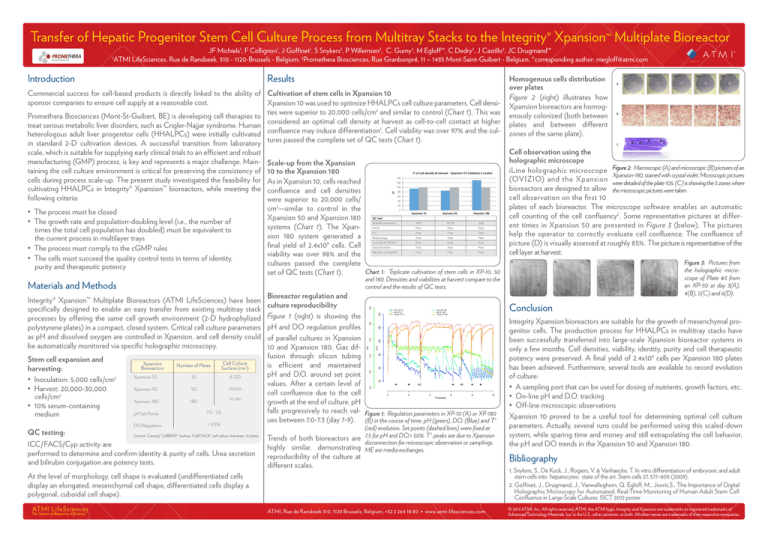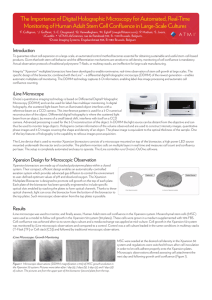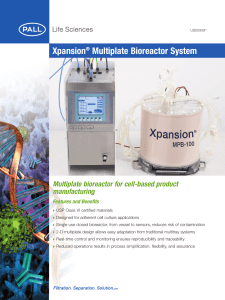
Transfer of Hepatic Progenitor Stem Cell Culture Process from Multitray Stacks to the Integrity® Xpansion™ Multiplate Bioreactor
JF Michiels1, F Collignon1, J Goffinet1, S Snykers2, P Willemsen2, C. Gumy2, M Egloff1*, C Dedry2, J Castillo2, JC Drugmand1*
ATMI LifeSciences, Rue de Ransbeek, 310 - 1120-Brussels - Belgium, 2Promethera Biosciences, Rue Granbonpré, 11 – 1435 Mont-Saint-Guibert - Belgium, *corresponding author: megloff@atmi.com
1
Results
Introduction
Commercial success for cell-based products is directly linked to the ability of Cultivation of stem cells in Xpansion 10
sponsor companies to ensure cell supply at a reasonable cost.
Xpansion 10 was used to optimize HHALPCs cell culture parameters. Cell densi2
Promethera Biosciences (Mont-St-Guibert, BE) is developing cell therapies to ties were superior to 20,000 cells/cm and similar to control (Chart 1). This was
treat serious metabolic liver disorders, such as Crigler-Najjar syndrome. Human considered an optimal cell density at 1 harvest as cell-to-cell contact at higher
heterologous adult liver progenitor cells (HHALPCs) were initially cultivated confluence may induce differentiation . Cell viability was over 97% and the culin standard 2-D cultivation devices. A successful transition from laboratory tures passed the complete set of QC tests (Chart 1).
scale, which is suitable for supplying early clinical trials to an efficient and robust
manufacturing (GMP) process, is key and represents a major challenge. Maintaining the cell culture environment is critical for preserving the consistency of
cells during process scale-up. The present study investigated the feasibility for
cultivating HHALPCs in Integrity® Xpansion™ bioreactors, while meeting the
following criteria:
• The process must be closed
• The growth rate and population-doubling level (i.e., the number of
times the total cell population has doubled) must be equivalent to
the current process in multilayer trays
• The process must comply to the cGMP rules
• The cells must succeed the quality control tests in terms of identity,
purity and therapeutic potency
Integrity® Xpansion™ Multiplate Bioreactors (ATMI LifeSciences) have been
specifically designed to enable an easy transfer from existing multitray stack
processes by offering the same cell growth environment (2-D hydrophylized
polystyrene plates) in a compact, closed system. Critical cell culture parameters
as pH and dissolved oxygen are controlled in Xpansion, and cell density could
be automatically monitored via specific holographic microscopy.
QC testing:
Number of Plates
Cell Culture
Surface (cm 2)
10
6,120
Xpansion 50
50
30,600
Xpansion 180
180
110,160
Xpansion
Bioreactors
Xpansion 10
pH Set Points
7.5 - 7.6
DO Regulation
> 50%
Control: Corning® CellBIND® Surface, CellSTACK® cell culture chambers, 10 plates
ICC/FACS/Cyp activity are
performed to determine and confirm identity & purity of cells. Urea secretion
and bilirubin conjugation are potency tests.
At the level of morphology, cell shape is evaluated (undifferentiated cells
display an elongated, mesenchymal cell shape, differentiated cells display a
polygonal, cuboidal cell shape).
ATMI LifeSciences
The Source of Bioprocess Efficiency™
Cell observation using the
holographic microscope
iLine holographic microscope Figure 2: Macroscopic (A) and microscopic (B) pictures of an
Xpansion-180, stained with crystal violet. Microscopic pictures
(OVIZIO) and the Xpansion were detailed of the plate 105. (C) is showing the 5 zones where
bioreactors are designed to allow the microscopic pictures were taken.
cell observation on the first 10
plates of each bioreactor. The microscope software enables an automatic
cell counting of the cell confluency2. Some representative pictures at different times in Xpansion 50 are presented in Figure 3 (below). The pictures
help the operator to correctly evaluate cell confluence. The confluence of
picture (D) is visually assessed at roughly 85%. The picture is representative of the
cell layer at harvest.
Figure 3: Pictures from
the holographic microscope of Plate #3 from
an XP-50 at day 3(A),
4(B), 5(C) and 6(D).
and 180. Densities and viabilities at harvest compare to the
control and the results of QC tests.
Materials and Methods
Stem cell expansion and
harvesting:
• Inoculation: 5,000 cells/cm2
• Harvest: 20,000-30,000
cells/cm2
• 10% serum-containing
medium
Scale-up from the Xpansion
10 to the Xpansion 180
As in Xpansion 10, cells reached
confluence and cell densities
were superior to 20,000 cells/
cm2—similar to control in the
Xpansion 50 and Xpansion 180
systems (Chart 1). The Xpansion 180 system generated a
final yield of 2.4x109 cells. Cell
viability was over 98% and the
cultures passed the complete
Chart 1: Triplicate cultivation of stem cells in XP-10, 50
set of QC tests (Chart 1).
Homogenous cells distribution
over plates
Figure 2 (right) illustrates how
Xpansion bioreactors are homogenously colonized (both between
plates and between different
zones of the same plate).
Bioreactor regulation and
culture reproducibility
Figure 1 (right) is showing the
pH and DO regulation profiles
of parallel cultures in Xpansion
10 and Xpansion 180. Gas diffusion through silicon tubing
is efficient and maintained
pH and D.O. around set point
values. After a certain level of
cell confluence due to the cell
growth at the end of culture, pH
falls progressively to reach val- Figure 1: Regulation parameters in XP-10 (A) or XP-180
ues between 7.0-7.3 (day 7-9). (B) in the course of time. pH (green), D.O. (Blue) and T°
(red) evolution. Set points (dashed lines) were fixed at
Trends of both bioreactors are 7,5 for pH and D.O.> 50%. T° peaks are due to Xpansion
disconnection for microscopic observation or samplings.
highly similar, demonstrating ME are media exchanges.
reproducibility of the culture at
different scales.
ATMI, Rue de Ransbeek 310, 1120 Brussels, Belgium, +32 2 264 18 80 • www.atmi-lifesciences.com
Conclusion
Integrity Xpansion bioreactors are suitable for the growth of mesenchymal progenitor cells. The production process for HHALPCs in multitray stacks have
been successfully transferred into large-scale Xpansion bioreactor systems in
only a few months. Cell densities, viability, identity, purity and cell therapeutic
potency were preserved. A final yield of 2.4x109 cells per Xpansion 180 plates
has been achieved. Furthermore, several tools are available to record evolution
of culture:
• A sampling port that can be used for dosing of nutrients, growth factors, etc.
• On-line pH and D.O. tracking
• Off-line microscopic observations
Xpansion 10 proved to be a useful tool for determining optimal cell culture
parameters. Actually, several runs could be performed using this scaled-down
system, while sparing time and money and still extrapolating the cell behavior,
the pH and DO trends in the Xpansion 50 and Xpansion 180.
Bibliography
1. Snykers, S., De Kock, J., Rogiers, V. & Vanhaecke, T. In vitro differentiation of embryonic and adult
stem cells into hepatocytes: state of the art. Stem cells 27, 577–605 (2009).
2. Goffinet, J., Drugmand, J., Vanwalleghem, Q. Egloff, M., Jooris,S., The Importance of Digital
Holographic Microscopy for Automated, Real-Time Monitoring of Human Adult Stem Cell
Confluence in Large-Scale Cultures. ISCT 2012 poster
© 2013 ATMI, Inc. All rights reserved. ATMI, the ATMI logo, Integrity and Xpansion are trademarks or registered trademarks of
Advanced Technology Materials, Inc. in the U.S., other countries, or both. All other names are trademarks of their respective companies.








